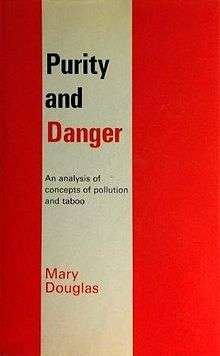Purity and Danger
 Cover of the first edition | |
| Author | Mary Douglas |
|---|---|
| Original title | Purity and Danger: An Analysis of Concepts of Pollution and Taboo |
| Country | United Kingdom |
| Language | English |
| Subject | Social anthropology |
| Publisher | Routledge and Keegan Paul |
Publication date | 1966 |
| Media type | |
| Pages | 196 pp. |
| ISBN | 0-7100-1299-3 |
| OCLC | 50333732 |
| Preceded by | The Lele of the Kasai |
| Followed by | Natural Symbols |
Purity and Danger: An Analysis of Concepts of Pollution and Taboo is a 1966 book by the anthropologist and cultural theorist Mary Douglas. It is her best known work. In 1991 the Times Literary Supplement listed it as one of the hundred most influential non-fiction books published since 1945. It has gone through numerous reprints and re-editions (1969, 1970, 1978, 1984, 1991, 2002). In 2003 a further edition was brought out as volume 2 in Mary Douglas: Collected Works (ISBN 0415291054).
Summary
The line of inquiry in Purity and Danger traces the words and meaning of dirt in different contexts. What is regarded as dirt in a given society is any matter considered out of place. (Douglas took this lead from William James.) She attempted to clarify the differences between the sacred, the clean and the unclean in different societies and times. But this does not entail judging religions as pessimistic or optimistic in their understanding of purity or dirt—e.g., as dirt-affirming or otherwise. Through a complex and sophisticated reading of ritual, religion, and lifestyle, Douglas challenged Western ideas of pollution, making clear how the context and social history is essential.
As an example of this approach, Douglas first proposed that the kosher laws were not, as many believed, either primitive health regulations or randomly chosen as tests of the Israelites' commitment to God. Instead, Douglas argued that the laws were about symbolic boundary-maintenance. Prohibited foods were those that did not seem to fall neatly into any category. For example, pigs' place in the natural order was ambiguous because they shared the cloven hoof of the ungulates, but did not chew cud.
Later in a 2002 preface to Purity and Danger, Douglas went on to retract this explanation of the kosher rules, saying that it had been "a major mistake." Instead, she proposed that "the dietary laws intricately model the body and the altar upon one another." For instance, among land animals, Israelites were only allowed to eat animals that were also allowed to be sacrificed: animals that depend on herdsmen. Douglas concluded from this that animals that are abominable to eat are not in fact impure, but rather that "it is abominable to harm them." She claimed that later interpreters (even later Biblical authors) had misunderstood this.
Influence
The historian of Late Antiquity, Peter Brown states that Purity and Danger was a major influence behind his important 1971 article The Rise and Function of the Holy Man in Late Antiquity, which is considered one of the bases for all future study of Early Christian asceticism.[1]
In Powers of Horror (1980), where Julia Kristeva elaborates her theory of abjection, she recognizes the influence of Douglas’s “fundamental work,” while criticizing certain aspects of her approach.[2]
Reviews
- Edwin Ardener in Man, New Series, 2:1 (1967), p. 139.
- Melford Spiro in American Anthropologist, New Series, 70:2 (1968), pp. 391–393.
- William McCormack in Journal for the Scientific Study of Religion, 6:2 (1967), pp. 313–314.
- Joseph B. Tamney in Sociological Analysis, 28:1 (1967), pp. 56–57.
- Phillip R. Kunz in Review of Religious Research, 10:2 (1969), pp. 114–115.
- Albert James Bergesen, review essay in American Journal of Sociology, 83:4 (1978), pp. 1012–1021 (also dealing with Douglas's later book, Natural Symbols).
- P. H. Gulliver in Bulletin of the School of Oriental and African Studies 30:2, Fiftieth Anniversary Volume (1967), pp. 462–464.
See also
References
- ↑ Brown, Peter (1998). "The Rise and Function of the Holy Man in Late Antiquity, 1971-1997". Journal of Early Christian Studies. 6: 359–63.
- ↑ Kristeva, Julia, Trans. Leon Roudiez (1982). Powers of Horror: An Essay on Abjection. Colombia University Press: 65-67.
Bibliography
- Richard Fardon, Mary Douglas: An Intellectual Biography (London: Routledge, 1999), ch. 4.
External links
- 2002 edition on google books
- Leonore Davidoff, "Speaking Volumes: Purity and Danger", Times Higher Education Supplement 19 May 1995. Accessed 22 March 2010.